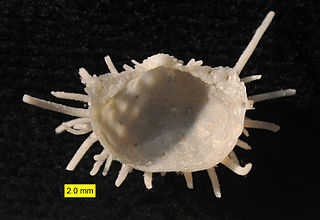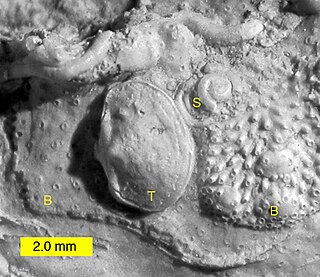 W
WThe Acrotretida are a group (order) of sessile, suspension-feeding brachiopods known from the Cambrian period and surviving until the present day. Their shell has a round outline, and is usually phosphatic in recent specimens.
 W
WAthyridida is an order of Paleozoic brachiopods included in the Rhynchonellata, which makes up part of the articulate brachiopods.
 W
WThe Craniidae are a family of brachiopods, commonly known as lamp shells. Although it belongs to a subdivision called the inarticulata which have shells where the mineral content consist of calcium phosphate, the Craniidae have shells that consist of calcium carbonate. Other special characteristics of this family are that no outgrowths are developed to form a hinge between both valves, nor is there any support for the lophophore. As adults, craniids either lived free on the ocean floor or, more commonly, were attached to a hard object with all or part of the ventral valve. All other brachiopods are supposed to have a stalk or pedicle, at least as an adolescent, but in craniids a pedicle is not known from any development stage.
 W
WLingulida is an order of brachiopods.
 W
WOrthida is an extinct order of brachiopods which appeared during the Early Cambrian period and became very diverse by the Ordovician, living in shallow-shelf seas. Orthids are the oldest member of the subphylum Rhynchonelliformea, and is the order from which all other brachiopods of this group stem. Physically they are usually strophic, with well-developed interareas. They also commonly have radiating ribs, sulcus, and fold structures. Typically one valve, often the brachial valve, is flatter than the other. The interior structure of the brachial valves are usually simple. In shape they are sub-circular to elliptical, with typically biconvex valves.
 W
WPentamerida is an order of biconvex, impunctate shelled, articulate brachiopods that are found in marine sedimentary rocks that range from the Middle Cambrian through the Devonian.
 W
WProductida is an extinct order of brachiopods in the extinct class Strophomenata.
 W
WThe taxonomic order Rhynchonellida is one of the two main groups of living articulate brachiopods, the other being the order Terebratulida. They are recognized by their strongly ribbed wedge-shaped or nut-like shells, and the very short hinge line.
 W
WSpiriferida is an order of extinct articulate brachiopod fossils which are known for their long hinge-line, which is often the widest part of the shell. In some genera it is greatly elongated, giving them a wing-like appearance. They often have a deep fold down the center of the shell. The feature that gives the spiriferids their name ("spiral-bearers") is the internal support for the lophophore; this brachidium, which is often preserved in fossils, is a thin ribbon of calcite that is typically coiled tightly within the shell.
 W
WStrophomenida is a large, extinct order of articulate brachiopods in the extinct class Strophomenata that existed from the lower Ordovician to the lower Jurassic period. It was the largest known order of brachiopods, encompassing over 400 genera, including the largest and heaviest of known brachiopod shells. The strophomenids lost the ability to attach by the stalk in adult specimens, so they either lay free, attached the ventral valve at the umbo to a firm substrate, or balanced with their spines sunken into a soft substrate. Typically the dorsal valve was either concave or flat, though occasionally it was convex; the ventral valve was convex. Typically, a member of this order was wider than it was long. In juveniles, there was a tiny hole at the animal's umbo for a stalk to emerge from. Tiny bumps cover the interior of the valves.
 W
WTerebratulids are one of only three living orders of articulate brachiopods, the others being the Rhynchonellida and the Thecideida. Craniida and Lingulida include living brachiopods, but are inarticulates. The name, Terebratula, may be derived from the Latin "terebra", meaning "hole-borer". The perceived resemblance of terebratulid shells to ancient Roman oil lamps gave the brachiopods their common name "lamp shell".
 W
WThecideida is an order of cryptic articulate brachiopods characterized by their small size and habit of cementing their ventral valves to hard substrates such as shells, rocks and carbonate hardgrounds. Thecideides first appear in the Triassic and are common today.